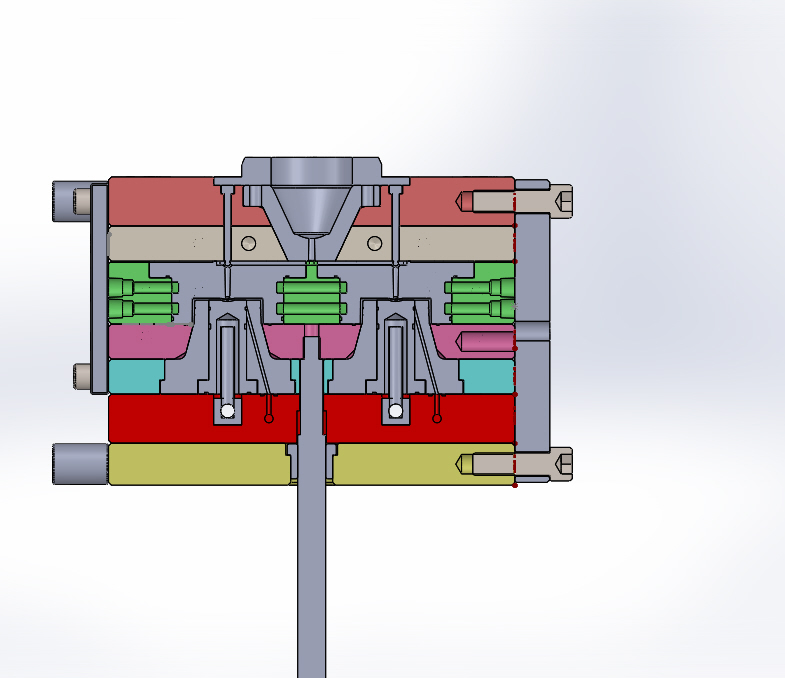- Home
- Lean Principles
- Machine Selection
- Mold Design
- Mold Interlocking
- Mold Making
- Plastic Material Technology
- Molding Process
- Plastic News
- What's New
- Privacy Policy
- Disclaimer
- Site Map
- Poll
- Polishing
- 3D Rapid Prototyping
- Molding Companies
- Contact Us
- Proven Thinwall Packaging Mold Designs For Sale
- MOLD WEIGHT CALCULATOR
- HOT RUNNER VERSUS COLD RUNNER
Moldmax In Injection Molding
Moldmax is a registered trademark name for a number of copper alloy materials that are designed for the plastic injection molding industry. They are available in a variety of shapes and sizes, can be machined with conventional toolmaking machinery, can be welded and coated for extra abrasive resistance but the main advantage are their high heat conductivity compared to tool steels such as P20 and H13.
It has a heat transfer rate 3 to 4 times faster than tool steels so has the potential to improve cycle times and part quality.
Not A Substitute For Poor Injection Mold Design
To get the greatest benefit from moldmax materials, they should be used in areas of an injection mold that cannot be sufficiently cooled using normal mold building techniques.
When part design doesn't allow enough room for cooling channels to get close to the molding surface to sufficiently cool a particular area, moldmax will be of benefit compared to tool steel. For example, areas where there are many deep ribs that are close together that do not allow enough room to drill cooling channels.
Not A Substitute For Poor Part Design
Parts that have been designed with extra thick walls are difficult to cool because plastics are a natural insulator. As plastic is injected into a mould cavity the outside layer that touches the cavity wall has already become solid and this will limit the heat transfer between the inside of the part and the mould cavity. Naturally, parts with thick walls will take longer to cool than parts with thinner walls no matter what mould material is used.
That’s why when designing plastic parts the thinnest wall section possible in line with the application should be used and it should be uniform. Having thick and non-uniform wall sections will cause hot spots in a mold and set up extra stresses in the part and will likely cause part warpage or distortion and longer than necessary mold cooling times.
Similarly, part shape can also have a significant effect on cooling rates and quality. It is easy to get even cooling in flat parts such as container and lids because they allow the use of conventional machining processes such as drilling to be used. However, when the part is a complex 3D shape then more consideration must be given to the mold cooling system.
It is often the case however, that part design can be modified to allow even cooling especially during the early stages of a project. Part designers need to have a sound knowledge of mold cooling design in order to avoid the possibility of hot spots which inevitably lead to low productivity levels and poor quality parts.
Although mold-max might help to improve part quality and productivity levels in some cases, the best solution is to design a part that will allow proper mold cooling design in the first place.
Flexibility
Moldmax has many of the advantages of tool steels so it can be used in a wide variety of applications. It can hold nickel, chromium and ceramic coatings such as TiN. There is no one coating that is right for all applications. Each coating will provide different degrees of corrosion resistance, easier mold release of parts during ejection, scratch resistance, and wear resistance from glass reinforced materials.
It can also be polished to a mirror finish. This gives parts an attractive cosmetic finish. Care must be taken however, during the polishing process not to apply too much pressure for too long or the polished surface will become pitted and detract from the surface finish of the part. From this point of view, tool steel is easier to polish.
Mold max can be welded. This is a big advantage because mold building materials can be damaged in a number of ways during the molding process and welding provides a quick and effective way of repairing.
Disadvantage
Moldmax requires more mold maintenance than tool steels. Over a period of time, the surface can lose its shine and develop some greenish corrosion. Although this can be cleaned and brightened, special procedures using acids need to be followed. This means mold max components will need to be removed from the mold and be cleaned in a suited vented area for safety reasons. Whereas, tool steels can be cleaned in the molding machine saving valuable production time.
Additional Comments
Although the material cost is higher than that of tool steel, when used for the right application, moldmax increases productivity while maintaining quality. It is not a substitute for poor part design, poor injection mold design or incompetent die setting or processing.
Return from Moldmax In Injection Molding to Injection Mold Design
Return from Moldmax In Injection Molding to HomePage
References
1. Cleaning Mold MAX and PROtherm Molds, Tech brief, Materion Brush Performance Alloys.
2. Mold Max Technical Brochure , Edition 4, 05-2011 Bohler Uddeholm Alloy Steels





